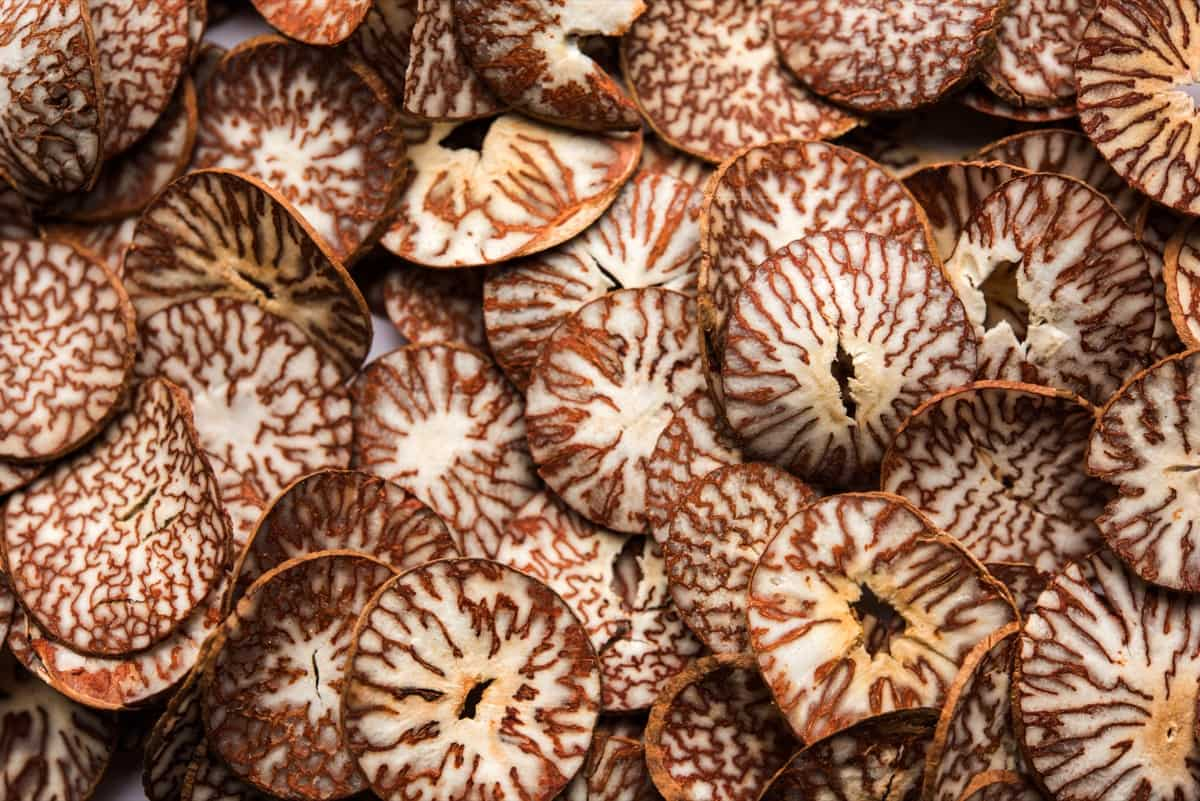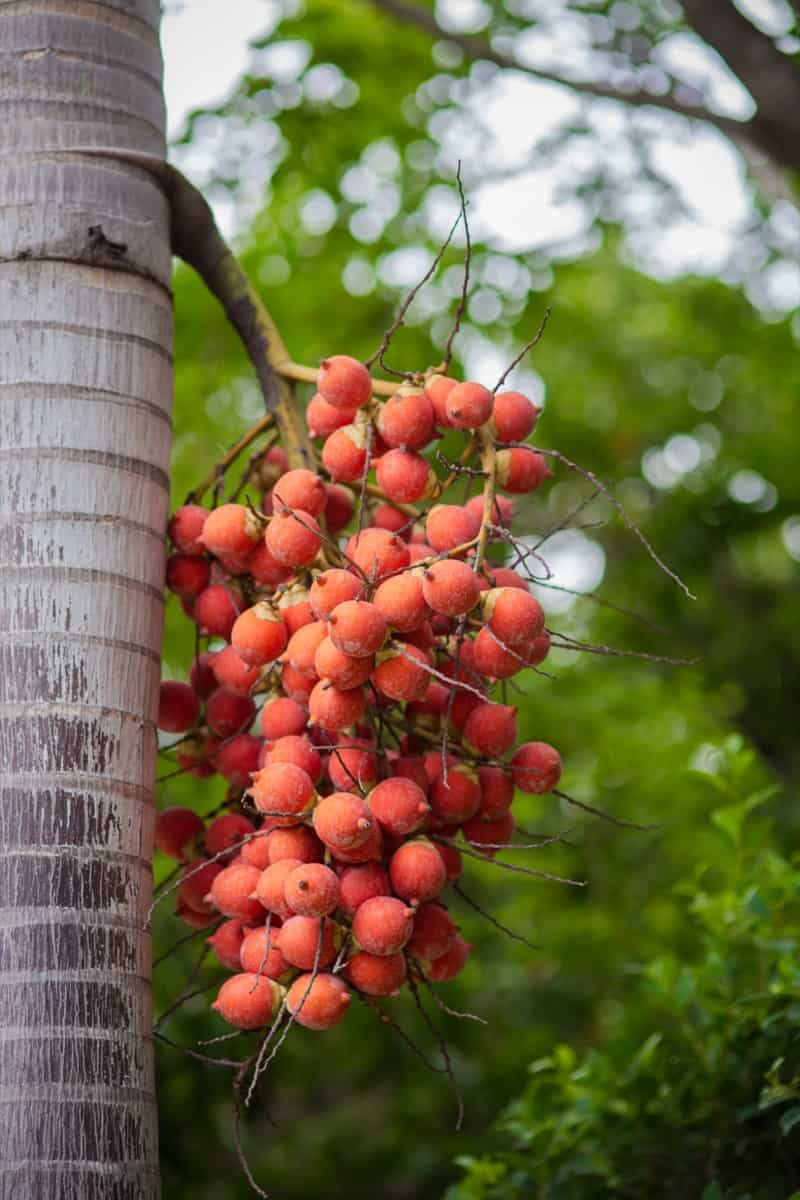The Areca Nut palm (Areca catechu L.) tree is one of the important commercial crops. In addition, the Areca Nut palm is the source of a common chewing nut, popularly called betel nut or Supari.
Areca Nut Profit Per Acre
Climate and Soil Requirement for Areca Nut Farming
It grows well within the temperature range of 14ºC and 36ºC and is affected by temperatures below 10ºC and above 40ºC. Extremes of temperature and wide variations are not conducive to the healthy growth of the palms. It can be grown in areas receiving annual rainfall of about 750 to 4,500 mm. The Areca Nuts are irrigated in areas with a prolonged dry spell.
In case you missed it: Can You Grow Okra from Store-bought Okra: A Step-by-step Process Guide

One of the most important aspects of betel nut cultivation is ensuring that the soil is of good quality. The soil pH level between 5.5 and 6.5 is best for Areca Nut. Betel nut trees require a lot of water, so irrigation is important for betel nut cultivation. Drip irrigation is often used to minimize water wastage.
The Different Types of Areca Nut
Areca Nuts are the seeds of the Areca palm, which is grown in tropical climates worldwide. There are four main types of betel nuts – white, red, black, and yellow. White betel nuts are the most popular type and are typically used in chewing tobacco. Red betel nuts have a strong flavor and are used in Ayurvedic medicine. Black betel nuts are less common and have a milder flavor. Finally, yellow betel nuts are the least common type and taste bitter.
Is Areca Nut Farming Profitable?
With the additional income from the Areca Nut crop, one acre of land can yield a very good profit.
Areca Nut Planting Distance
Betel nut plants should be spaced 20-30 feet apart in rows 10-15 feet apart. If you use a system of multiple rows, the first row should be planted 30-40 feet away from the second. This will ensure that each plant has enough room to grow and produce Betel nuts.
Irrigation Requirement for Areca Nut Cultivation
Areca Nut trees cannot withstand drought for a long time. Being a perennial crop, once affected by water stress, it can require 2-3 years to regain normal vigor and yield. The death of Areca palms due to moisture stress is also not uncommon. Therefore, irrigation intervals of about 5 and 10 days were superior throughout the season. The quantity of water to be applied is 200 liters per palm/irrigation. The important irrigation methods used in the Areca Nut crop are sprinklers and drip. Sprinkler and drip irrigation systems can save 20 and 44 percent of water.
Areca Nut Yield Improvement Tips
- Plant only high-quality, disease-free betel nut saplings.
- Space the plants evenly to ensure good air circulation and enable all the leaves to get adequate sunlight.
- Apply an adequate amount of organic manure and compost around the base of the plants.
- Water the plants regularly, especially during dry spells. Avoid overwatering the tree, as it can lead to root rot.
- Keep an eye out for pests and diseases and control them.
In case you missed it: Controlled Agriculture in North and West Yorkshire: Next Agricultural Revolution

Areca Nut Cultivation Practices to Get More Yield
- Fertilizers are also an important part of betel nut cultivation. A common fertilizer mix for betel nuts includes nitrogen, phosphorus, and potassium. To avoid over- or under-fertilization, fertilizer should be applied based on soil test results.
- Areca Nut trees also need to be given a small amount of fertilizer every few years. The best time to fertilize Areca Nut trees is during the rainy season. This will help the tree to absorb the nutrients more effectively.
- Pest and disease control is also an essential aspect of betel nut cultivation. Some common pests and diseases include leaf spots, stem borers, whiteflies, and root rot. Effective control measures should be taken to prevent these pests and diseases from damaging crop yield.
Cost Of Areca Nut Cultivation Per Care
The cost of cultivation for Areca Nuts is quite high, requiring a lot of labor and expertise to grow them. Areca Nut trees are tall and require a lot of growing space, so the planting distance must be significant. They must also be intercropped with other plants, such as coconuts, to provide shade and support. The yield of Areca Nuts is also quite low, so the farmer must carefully manage the harvest to ensure a good profit. The cost of cultivation can vary depending on the size of the farm and the region where it is located. In general, the cost of cultivation involves:
- Land preparation costs, including tilling, weeding, and leveling
- Seedling costs, including purchasing or propagating plants
- Fertilizer and pesticide costs
- Labor costs for planting, maintaining, and harvesting the crop
- Transportation costs for delivering the crop to market
- The cost of cultivation of Areca Nut varies from region to region. But generally, it costs around Rs 30,000 – 40,000 per acre.
Which is the Best Intercrop for Areca Nut?
Pepper is the most compatible perennial spice crop with Areca Nut and can grow profitably. There is no detrimental effect on the yield of Areca Nut palms due to training black pepper on them. Further, it helps to augment the farmer’s income by mixed cropping of black pepper. Intercropping Areca Nut with Betelnut leaves, Black pepper, and Banana is common.
The primary considerations when choosing intercrops for Areca Nut are compatibility with the Areca Nut trees (e.g., shade tolerance) and marketability. For example, the Banana is a popular intercrop choice in Kerala because it is compatible with Areca Nut trees, and there is strong demand for bananas in the region. In addition, these intercrops can provide valuable nutrients and shade to the betel nut palms, leading to increased yield potential.
When and How to Harvest Areca Nut?
Areca Nut trees are generally ready for harvest after 3-4 years of planting. However, the exact time will depend on the variety of Areca Nut cultivated and the local climate. Areca Nut harvesting is typically done by hand, with workers climbing up the trees to cut down the ripe fruits. The harvested fruits are then taken to a processing unit, cleaned, and sorted.
In case you missed it: How to Build a Pergola on Terrace: DIY, In Simple Steps for Vine Plants

Betel Nut Yield And Profit Per Acre
- The average yield per acre is around 1,500 kg.
- Areca Nut farming is a profitable venture with an average return of Rs. 50,000 – 60,000 per acre.
Conclusion
Areca Nut is a crop used for centuries in India and other Asia. This highly valuable and nutritious food crop makes betel nut a popular ingredient in Indian cuisine. Areca Nut farming profit per acre depends on many factors like cost of cultivation, planting distance, intercrops, yield, etc.
- Feed Your Flock for Less: Top 10 Tips to Save on Chicken Feed
- Ultimate Guide to Ossabaw Island Hog: Breeding, Raising, Diet, and Care
- Hatching Answers: The Top 10 Reasons Your Chickens Aren’t Laying Eggs
- Eggs and Economics: Breaking Down the Cost of Raising Backyard Chickens
- Defend Your Greens: Proven Methods to Keep Iguanas Out of Your Garden
- Ultimate Guide to Cinnamon Queen Chicken: A Comprehensive Guide for Beginners
- Ultimate Guide to California Tan Chicken: Breeding, Raising, Diet, Egg-Production and Care
- Ultimate Guide to Marsh Daisy Chicken: Breeding, Raising, Diet, and Care
- 10 Types of Chicken Farming Businesses You Can Start for Profits